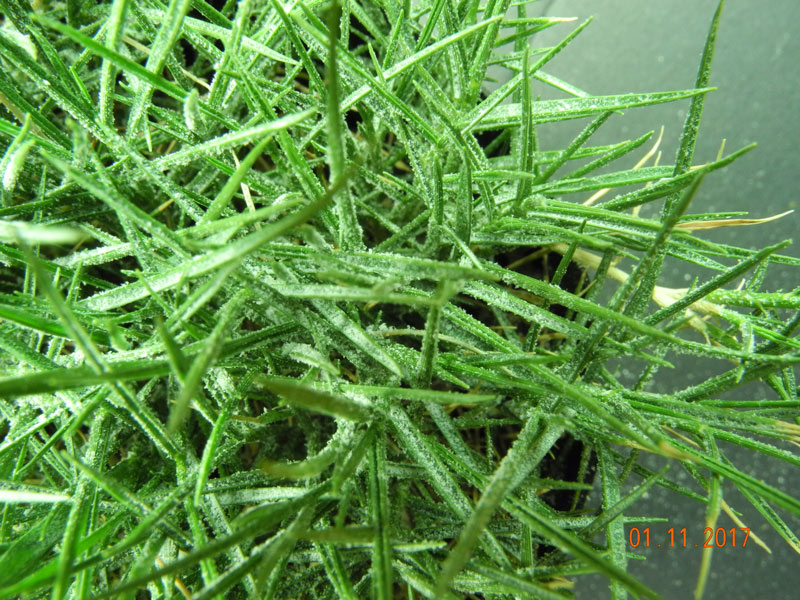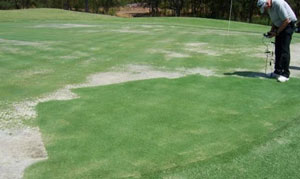
With zoysiagrass, salts are absorbed by the roots, are moved into the plant without tissue injury, and accumulate on the leaf surface through the biological characteristic of having very active salt glands — a characteristic unique to zoysiagrass. Photos courtesy of Team Zoysia
Editor’s note: In conjunction with “Zoysia and the Future of Golf: Fewer Inputs from Tee to Green,” a learning tour at the 2018 Golf Industry Show in San Antonio, GCMOnline.com is presenting a series of stories on zoysiagrass, its increasing prominence in golf, and the learning tour itself, provided by Team Zoysia.
Blogs, tweets, abstracts and books have been written on dealing with salinity in the golf industry. Most often, improved cultivars of Paspalum have been marketed as the only solution to dealing with salinity. Marketing aside, my more than three decades as a turfgrass scientist have shown me there’s a better answer to salinity issues. That answer is zoysiagrass.
The Paspalum problem
The science behind dealing with salinity has been somewhat heavily skewed toward containment or mechanically moving excessive salts through the soil profile through leaching, flushing and/or chemical treatment. Paspalums are known halophytes — they exclude salts from concentration in the leaf tissue to avoid salt tissue injury, and, as such, they can tolerate exceptionally high concentration of salts in the root zone and soil profile, at least up to a point.
Seasonally, nearly every environment will experience prolonged periods of low rainfall and possibly even drought, during which time evaporation of surface waters draws saline-laden moisture to the surface where the salts accumulate. Once salt accumulation reaches a critical level, even the Paspalums will begin to suffer. At this point, the only true resolve is to dramatically increase the level of water application to 1) help resolubilize the accumulated salts, and 2) force downward movement of these salts lower in the soil profile, from which they will rise again and require that the process be repeated, usually on a 15- to 30-day cycle, once to several times during the season. Hearsay suggests that as much as 30 percent of the total water needed for turf maintenance of Paspalum is required for flushing and/or leaching salts.
The zoysiagrass solution
In 1982, I had the personal experience of collecting exotic plant materials — namely zoysiagrasses — from the edge of salt beds along the Yellow Sea in Korea. These grasses were literally growing and thriving in nearly pure-salt soil. Over the past 35 years, I have had the opportunity to research the zoysia species, and develop and be involved in developing numerous varieties with a multitude of excellent agronomic characteristics — tolerance to drought, shade, traffic and wear; resistance to diseases and insects; and a broad area of climatic and soil adaptations, from 45 degrees N latitude to 45 degrees S, and from acid to alkaline soils.
One of the most striking characteristics has been the plant’s inherent ability to deal with the sodium Na ion (salt). While salt accumulation can wreak havoc on plant tissue and destroy soil structure, the adaptation of grasses that can survive in these climes naturally holds great promise for the future of the game of golf. We often refer to zoysia as a “game changer,” and we can cite a multitude of biological traits of the species that enable this. However, the greatest game changer, in my opinion, is understanding how zoysiagrass differs from Paspalums and other species noted for being salt-tolerant.

The photo to the right, taken in North Texas in 2006, shows zoysiagrass on a previously creeping bentgrass green. A three-year drought claimed the bentgrass, as the soil profile reached in excess of 17,000 ppm salts through the soil profile. In a single season of having zoysiagrass on the green, the saline level of the soils dropped dramatically, and within three years, we found no noticeable level of salinity at all. The clippings were removed with each mowing, and the tissue, when tested, measured as much as 10,000 ppm. All greens were renovated, and by 2010, the course was surviving.
As a follow-up to this experience, we have just completed an independent research study comparing a noted variety of Paspalum with several zoysiagrasses, with interesting and exciting results. M85 is one of the best zoysiagrasses available, and it deals with salts much better than Paspalum by extraction of salts from the soil, allowing full soil remediation. Poor soils and poor-quality water are less of an issue with a grass like M85.
The top photo provides exciting evidence of how zoysiagrass deals with salts. In short, the salts are absorbed by the roots, are moved into the plant without tissue injury, and accumulate on the leaf surface through the biological characteristic — unique to zoysiagrass — of having very active salt glands. These salt glands will contain salts, and when high enough concentrations are reached, they will exert the salt crystals to the leaf surface, as seen in the photo. Under normal mowing practices, these salt-laden glands are routinely removed (mechanically through mowing) and the soil remains healthy without extra remedial leaching or flushing required.
Granted, it does require that clippings be gathered and removed during drought and high evapotranspiration (ET), otherwise salts will stay in the soil profile and could cause issues, as with any other grass. But let’s consider the differences. First, building excessive drainage in the soil profile isn’t really necessary — zoysia removes the salt upward, not downward (do we really need a USGA greens profile then?). Mechanical removal is accomplished with routine mowing (don’t use the clippings for mulching around flower beds — salt levels may be a bit high [10,000+ ppm]). Second, excellent advances in zoysiagrass development have occurred over the past couple of decades, and, more recently, even greens-grade grasses that require less fertilizer, mowing and irrigation have been developed. We can attain 9-plus Stimpmeter readings, even using a triplex-type greens mower. The most recent round of grasses (such as M85), when managed at even a slightly higher level, are being reported as 10-plus on the Stimpmeter.
Zoysiagrass beyond salinity
As important as dealing with salinity is, we have also been able to attain the desired green speeds, as mentioned, but we now believe it is possible to go tee-to-green — and I dare say, even wall-to-wall — with a single grass. This is possible with the newer zoysiagrasses such as M85 and L1F, and can also be a major changer — the maintenance of a golf course with a single grass, the only difference being the height and the way it is mowed.
I offer these thoughts following more than three decades of research, management and firsthand experience. I spent 31 years with Texas A&M University developing new grasses for the turf industry. I have developed and released more than 25 individual grasses, and yet I find the developments of today, such as M85 and others now emerging, finally attaining the expectations and dreams of a retired professor. Zoysiagrass is a game changer.
To learn more about zoysiagrass, attend the “Zoysia and the Future of Golf: Fewer Inputs from Tee to Green” learning tour at the 2018 Golf Industry Show in San Antonio.
M.C. (Milt) Engelke, Ph.D., is professor emeritus at Texas A&M University.